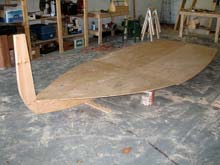I recently joined the community of eccentrics who not only want a boat, but need to get one the hard way. As I write, my garage has become an impromptu boatyard where the keel and bottom boards of a Stevenson Pocket Cruiser are in place and the deck boards are lofted and ready to cut. Some day—soon, I hope—there will a boat worth sailing down the Chesapeake Bay.
 |
My garage has become an impromptu boatyard where the keel and bottom boards of a Stevenson Pocket Cruiser are in place. |
I cannot easily justify this project. I don’t live on the water, nor am I an experienced sailor. The last boat I built was made out of paper and most of my nautical vocabulary comes from Mutiny of the Bounty and Pirates of the Caribbean. Until recently, I betrayed no obvious interest in the sea.
Most of the usual rationalizations given by middle age family men who decide to build boats don’t apply. I can’t really claim that this is a father-son or father-daughter project. My three children are vaguely interested, but they don’t spend much time in the garage when I’m cutting plywood and driving screws. I think their interest will grow but, for now, the only thing I am bonding with is a sticky pot of plastic resin glue.
And my wife? I’ll tell more about Hilary in future columns. She’s a dear and very special to me. She offered encouragement when I finally admitted, somewhat sheepishly, that I wanted to build a boat and embark on a small adventure. But she has no interest in sailing. She gets seasick and views sailing as a lonely, vaguely antisocial activity. Sailing, she once theorized, is “a guy thing.”
I have no place to hide and no one to blame but myself. In a court of law, insanity would be my best defense.
But I find some comfort in numbers. I happen to know that I am not the first middle-aged family man to show a sudden interest in building a boat and sailing away (however briefly). For many of us, sailing is ultimately about the fantasy of escape. And it doesn’t take a psychologist to understand why.
There are millions men who check off all the usual milestones of adult life—marriage, children, and mortgage—and follow the middle class rulebook to the letter. We pay the bills, clean the gutters, take out the trash, and change the oil every three thousand miles. We’re good husbands and good dads and we don’t want to change a thing.
But gray hair and birthday cakes with more than forty candles put some of us in a reflective mood. We understand that time is running short. Suddenly vague fantasies from childhood reappear and tap us on the shoulder. We try to ignore them, but they persist and, eventually, we have to take action or let them go, once and for all.
Some hike Everest, some learn to fly, some paint landscapes in Provence. But thousands more find themselves thumbing through boating magazines and reading Sailing Alone Around the World.
Those of us with the least experience as sailors have the most vivid fantasies. Unencumbered by the hard realities of sailing, it’s easy to cultivate images of idyllic adventures: There I am at the tiller, squinting into the wind as I skillfully navigate the open seas; that’s me in a paneled cabin, wearing my Shetland wool sweater while reading a book by the light of an oil lamp; and here I am anchored off a tropical island, barefoot and shirtless. My, how tan and muscled I look!
Countless men have fallen under the spell for generations. Now that I am reading—with a kind of obsessive devotion—the vast literature of sailing adventure, I see that I am following a well-worn path to the sea. Generation after generation, men hit midlife and rush to the water’s edge. Like British travel writer Jonathan Raban, who bought an old boat and spent four years circumnavigating his country, we find ourselves suddenly “besotted by the idea” of sailing and the freedom it implies.
In Coasting: A Private Voyage, Raban writes, “I was nearly forty…when I bought a real boat, fitted it up as a floating house and set out to sail alone around the British Isles. It was rather late in the day to run away to sea (thirteen is supposed to be the standard age for that chronically English escapade) but I wasn’t going to let ordinary caution or common sense get in the way of this imperious compulsion.”
You said it, brother.
But why do some of us feel compelled to build our boats? That was the very logical question asked by my uncle, a retired university professor and lifelong sailor. Outside of my immediate family, he was the first to learn of my plan when I wrote to ask for his advice. He had decades of experience sailing in the Pacific and I was inclined to do whatever he recommended. But his e-mailed response was not encouraging.
“You say that you want to build a boat and if that is your primary goal, then I guess you’ll have to build a boat,” he began. “But if your primary goal is sailing, then I do not recommend that you build a boat. I recommend that you buy a good used fiberglass boat that meets your needs. The lines of a home-made wood boat are never as sweet as those of a fiberglass boat either in appearance or for moving through the water.”
This is sound advice, and as if to prove his point, another relative wrote to tell me that he had recently purchased a very serviceable 22-foot fiberglass sailboat for $2,300. This was noticeably less than what I expected to spend on materials alone. No, building was not easy to justify financially, nor did it make much sense for those who are eager to get on the water.
But my uncle’s comments helped me realize that while sailing is the ultimate goal, it is not the only goal. I wanted to get to the water, but I wanted to enjoy the process of getting there. To me, days and months spent on Craigslist or with boat brokers looking for a decent boat at a good price didn’t sound like fun. But building a boat did. For better or worse, building was part of the fantasy.
Unexpectedly, the hardest part was picking the right boat. With so many choices, I got lost for weeks searching through all of the many Web sites devoted to boat building. Each new design was prettier than the last and all fed my fantasies. But this kind of window shopping was keeping me from making a decision.
My time was not entirely wasted. The many hours spent on the computer gave me a passing familiarity with some of the most popular builders and designers. I learned about the work of Phil Bolger (and the passionate debate his designs can inspire between his supporters and detractors), and I knew the Glen-L catalog inside and out.
But as weeks passed without resolution, I realized that I had to get serious and toss aside unrealistic fantasies. I might see myself on a tropical island, but I don’t have the skills or time needed to get there, not for a while at least. And I certainly wouldn’t leave my family for weeks on end (nor could I build a boat big enough for all five of us). Dreams of Robinson Crusoe adventures were - reluctantly - abandoned.
But I also rejected suggestions that I start with something small—a rowboat perhaps—and launch on a nearby lake. After all these years of dreaming, that image seemed, well, anticlimactic. And while I greatly admire people who take this slow and methodical path to developing their boat building skills, I’m too impatient. For me, building a boat should lead to some kind of adventure, a journey from Point A to Point B, and the sooner the better.
Everything fell into place when I woke up one morning absolutely certain that I wanted to sail down the Chesapeake Bay--not all the way, perhaps, but for a few days at least. I had lived in the Eastern Shore of Maryland for several years and knew its shoreline well. The thought of wandering the coastline and visiting hard-to-reach inlets suddenly sounded enticing. It wasn’t Fiji, I admitted to myself, but it was good enough.
My three children are vaguely interested, but they don’t spend much time in the garage when I’m cutting plywood and driving screws.
photo by Hilary Boyer |
 |
With this plan in mind, I returned to the Internet with a new sense of purpose. I didn’t need a 30-foot sloop, but I needed more than a daysailer. I zeroed in on small sailboats with tiny cabins, and learned that they represent a distinct class of boats called pocket cruisers. They were trailerable, and many were cheap and relatively easy to build. Despite their diminutive size, the fulfilled my fantasy of a “real” sailboat and I could easily see myself at the tiller with the wind in my face.
I still had to choose from a dozen options. I seriously considered the Bolger Micro, but settled on the Stevenson Pocket Cruiser, which is lighter and (to my eye) has prettier lines. I knew that it, too, has its critics, but I was encouraged by the success stories of similarly inexperienced builders.
Work started on the first warm days of spring, which brings me full circle—back to the glued keel and lofted deck boards, waiting for assembly. I’ve made a few small mistakes and I now see how much work goes into even a small and “simple” boat. I have some experience as a woodworker, but this isn’t anything like building bookcases or kitchen cabinets—with so many curves and angles, I feel like I am working and thinking in four dimensions, not three. But each step, when done with care, is manageable and I know that I will indeed have a boat to sail in the not-too-distant future.
I won’t offer advice; anyone who is one step ahead of me is the more experienced builder. But for those of you are waiting on the sidelines, wondering if you can build a boat, I offer my encouragement. It might be impractical; it might make the neighbors talk. But why be timid and conventional? That’s for old people--and I’m feeling younger every day. |

